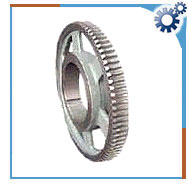 The gears made of cast iron have low cost of manufacture, are easy to
machine with high damping. Cast iron has good machining characteristics
like dry cutting, better dimensional stability, longer cutter life, and
superb surface finish.
The gears made of cast iron have low cost of manufacture, are easy to
machine with high damping. Cast iron has good machining characteristics
like dry cutting, better dimensional stability, longer cutter life, and
superb surface finish.Manufacturing
Cast iron gears are made by heating a blanket of cast iron and having a tooth forming part to such a temperature that it is compatible to the blanket. The teeth forming part is then pressed by projecting teeth of the rolling machine. The teeth forming part becomes hot. The blanket is then cooled and a teeth part is generated in the teeth forming part of the blanket. Hot rolling with low plastic deformation resistance prevents lowering of strength and improves gear accuracy.
Properties
Cast iron has good strength and has the ability to obtain hardness. This hardness can be provided by the use of alloys, heat treatment and surface hardening conditions. Mostly ductile iron is cast iron and because they have large volume of carbon in the matrix, they can easily provide suitable hardness to the gears.
Disadvantages
Gears made of cast iron have some weaknesses also. The casting is subjected to internal weakness from inclusions or blowholes that cannot be detected except by ultra sonic inspection. The mechanical properties of cast iron are generally low which can only be overcome by producing gears with sufficiently large faces or diameters to obtain the strength needed to handle the required the torque loads.
Applications
This material is widely used for commercial gears. Cast iron gears are widely used in grinding mills, sugarcane crushers, refining machine, filter press, power mills, and ice cream freezers.